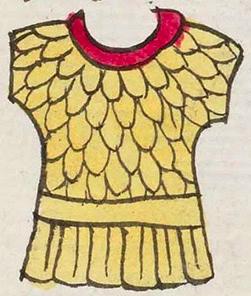huipilli (Mdz38r)
This simplex glyph of a huipilli is actually a yellow, feathered tunic (cozohuipilli). It doubles as the place name, Cozohuipilecan. It has red trim around the neck opening, short sleeves, a horizontal band toward the bottom of the tunic, and large straight yellow feathers hanging straight down below the band.
Stephanie Wood
The same glyph is counted in this collection for the place name, Cozohuipilecan, for (cozotl) yellow parrots (because of the feathers), and cozohuipilli (yellow parrot feather tunic or garment). Combining the tunic with the feathers almost makes this a compound glyph, although the features are so fused as to be difficult to atomize. This garment would appear to be something worn perhaps by a male warrior, despite the use of huipilli, which is usually a blouse worn by a woman. The pages of the Codex Mendoza that show lots of tribute items have warrior garments that are somewhat similar to this (see folio 36 forward). On folio 37 recto, for instance, there is a yellow garment with a red ring around the neck line. It is described as a "pieza de armas de plumas ricas," a warrior costume made with rich feathers.
Stephanie Wood
c. 1541, but by 1553 at the latest
huipil, huipiles, tunics, feathered, garments, feathers, plumas

tunic or blouse
Codex Mendoza, folio 38 recto, https://digital.bodleian.ox.ac.uk/objects/2fea788e-2aa2-4f08-b6d9-648c00..., image 86 of 188.
The Bodleian Libraries, University of Oxford, hold the original manuscript, the MS. Arch. Selden. A. 1. This image is published here under the UK Creative Commons, “Attribution-NonCommercial-ShareAlike 3.0 License” (CC-BY-NC-SA 3.0).



